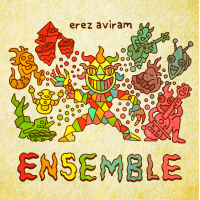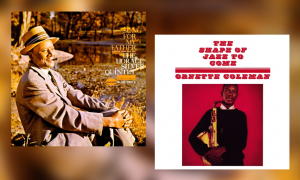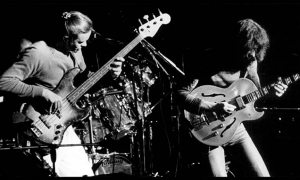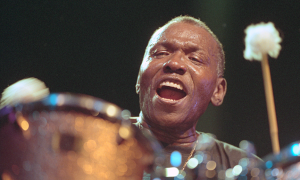Home » Jazz Articles » Building a Jazz Library » Shining A Light On Pianist Ron Thomas
Shining A Light On Pianist Ron Thomas
The Marilyn Monroe / Rachmaninoff epiphany led, eventually, to studies at the Manhattan School of Music, then with classical / electronic music pioneer Karlheinz Stockhausen, then The University of Illinois, and studies with pianist Roland Hanna. During his Illinois days, in 1965, Thomas experienced another epiphany—a jazz epiphany, brought on by an introduction to the music of Miles Davis and Bill Evans. An engagement in a personal battle between his classical and jazz sides ensued. The battle seems to have been a draw, and Ron Thomas recorded, in 1972, with guitarist Pat Martino.
Thomas held back on recording under his own name. With the exception of Wings Of The Morning (Vectordisc, 2008)—recorded in 1978, and released originally on vinyl, and as a 2008 re-release on CD—he didn't present a recording of his own until 2001's Scenes From A Voyage To Arcturus (Vectordisc). He had come to the conclusion that the hassle and hustle required to achieve fame and fortune was incompatible with the pursuit of his art on the level that it needed to be pursued. The arrival of Scenes From A Voyage To Arcturus, and a bunch of subsequent new millennium releases, say he decided well.
This is a partial listing from the discography of genius.
 Scenes From A Voyage To Arcturus
Scenes From A Voyage To Arcturus Vectordisc
2001
A majestically surreal and unclassifiable work blending electronic music, jazz and classical styling, this is Thomas' soundtrack of sorts to Scottish writer David Lindsay's 1920 novel, Voyage To Arcturus. These sometimes sweeping, sometimes stark musical landscapes exude a profound depth drawn from Thomas' lifelong immersion into mysteries of art and the universe.
 The House Of Counted Days
The House Of Counted Days Vectordisc
2002
This is Thomas in a quartet setting—the rhythm section and John Swana's trumpet. It's all Thomas originals, but the influence of Miles Davis is up front. Drummer Joe Mullen and bassist Tony Marino are perfect foils for Thomas' often complex ideas, adept at laying down grooves or moving into liquid reveries.
 Music In Three Parts
Music In Three Parts Art Of Life Records
2006
This is where the genius of Ron Thomas became undeniable, on a piano trio affair of the highest order. The type of fluid interplay between Thomas, drummer Joe Mullen and bassist Paul Klinefelter is rarely matched, and never transcended, on this set of Thomas compositions that are smooth and pliable. Of the recording session, Thomas says: ""We were precise about the materials and did not respond to the feelings about the musical events as they took shape. We were cool, I think, and got respectably close to the heightened lyrical intensity we were after." Indeed they did. A list of the top piano trio records of the twenty-first century should include this one.
 Doloroso
Doloroso Art Of Life Records
2006
Another piano trio released shortly after Music In Three Parts, Thomas' Doloroso represents part two of the finest pair of piano trio releases since Bill Evans' gave us Sunday At The Village Vanguard (1961) and Waltz For Debby (1962), both on Riverside Records. Though Evans is an obvious influence for Thomas, this music—erudite, free, mysteriously and elusively beautiful, full of a fluid trio interplay of the highest order—won't remind anyone of Evans' perfect explorations of the Great American Songbook and some Scott LaFaro tunes. What is undeniable Music In Three Parts and Doloroso is their otherworldly loveliness and perfection of execution and the cohesion of the presentation Thomas' complex and expansive artist vision.
 Two Lonely People
Two Lonely People Vectordisc
2011
This is Thomas' solo outing, something of a celebration of the spirit of Bill Evans. Three of the tunes included are Evans' originals. It also nods, in Thomas' words: [to] Jazz [that] like the best of all art, celebrates the timeless things of the human experience. Things ultimately beyond the constructs of new and old." A serene, inward-looking beauty is the result,not unlike that found on any of Evan's solo outings—a pensive and compelling jazz neo-classicism.
 Blues For Zarathustra
Blues For Zarathustra Art Of Life Records
2008
This duo outing finds Thomas in the simpatico company of bassist Paul Klinefelter, who also contributed to the previously-mentioned Music In Three Parts. Blues For Zarathustra is a set of mostly Great American Songbook tunes and standards, with one Thomas original, the title tune, included. And and while soothing and understated in execution—and remarkably beautiful—the partners in sound don't play things safe. "We'd rather take chances and go for that Mahler/Bill Evans synthesis," Thomas says on the liner notes of the teaming's similarly constructed release, Duo (Vecotrdisc, 2016). An exploration and re-discovery of lyrical intensity that—for Thomas and Klinefelter—is the very essence of the art of improvisation.
 Impatience
Impatience Vectordisc
2014
Another terrific trio set, a perfect example of the whole rising to a level above the sum of the parts. Included: one Bill Evans tune, three from the pen of Thomas, two more from the set's drummer Chris Loser, Legrand's "You Must Believe In Spring," centerpieced by the resplendent and uplifting sacred tune, "Ave Maria" (Bach-Gounod).
Tags
Building a Jazz Library
Ron Thomas
Dan McClenaghan
Karlheinz Stockhausen
Roland Hanna
Miles Davis
Bill Evans
Pat Martino
Joe Mullen
Tony Marino
Paul Klinefelter
PREVIOUS / NEXT
Support All About Jazz
 All About Jazz has been a pillar of jazz since 1995, championing it as an art form and, more importantly, supporting the musicians who make it. Our enduring commitment has made "AAJ" one of the most culturally important websites of its kind, read by hundreds of thousands of fans, musicians and industry figures every month.
All About Jazz has been a pillar of jazz since 1995, championing it as an art form and, more importantly, supporting the musicians who make it. Our enduring commitment has made "AAJ" one of the most culturally important websites of its kind, read by hundreds of thousands of fans, musicians and industry figures every month.





























